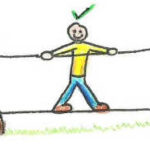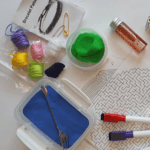
Library
You can search the files below by title or by the category drop down.
- Back in Balance Guide662.22 KBPreviewAdultCalming ToolsCognitiveEmotiveImaginativeSensoryTeens
A pamphlet that shows some simple steps to help you get back in balance when circumstance, emotions, or thoughts are bringing stress and throwing you off balance. You can download this brochure to your phone, computer, or tablet, or print it out and carry it with you.

- Calming Activities Library1.90 MBPreviewAdultAllyCalming ToolsChildrenCognitiveEmotiveImaginativeSensoryTeens
Certain activities can be a helpful activity to calm upset / anxious feelings and "rebalance". Here is a collection of suggested activities and steps you can do to use them in your daily life

- Calming Object Library1.93 MBPreviewAdultAllyCalming ToolsChildrenCognitiveEmotiveImaginativeSensoryTeens
Many objects can be used as a tool to help us calm upset or anxious feelings. Here is a collection of suggested items to try out for yourself!

- Children’s Lesson: Feeling Left Out1.49 MBPreviewAllyChildrenCognitiveEmotiveImaginativeSensoryAn interactive lesson for children aimed at building social skills. Videos and activities included. Recommended age 6-12.

- Children’s Lesson: Homesickness and Welcoming Others950.14 KBPreviewAllyChildrenCognitiveEmotiveImaginativeSensoryAn interactive lesson for children aimed at building social skills. Videos and activities included. Recommended age 6-12.

- Children’s Lesson: Who is a Good Friend?1.18 MBPreviewAllyChildrenCognitiveEmotiveImaginativeSensoryAn interactive lesson for children aimed at building social skills. Videos and activities included. Recommended age 6-12.

- Coping with Anxiety work book447.16 KBPreviewAllyCognitiveEmotiveImaginativeSensory
Here is a simple, and printable, work book that offering strategies on dealing with anxiety when it arises
- Emergency Plan Worksheet – What it is & Example670.18 KBPreviewAdultAllyCalming ToolsCognitiveEmotiveImaginativeMood DisorderSensoryTeensThought Disorder
You know a big event is coming, or some big change is about to happen in your life. This change will bring al kinds of emotions, & even unwanted thoughts, physical symptoms, & behaviours. What do you do? The Quirky Resource Emergency plan Worksheet will help guide you through the upcoming change or event so that you can feel more prepared it. We provide an example of the worksheet filled out.

- Emergency Plan Worksheet Blank353.52 KBPreviewAdultCalming ToolsEmotiveImaginativeMood DisorderSensoryTeensThought Disorder
We know that a big event is coming up, or a big change is going to happen. This worksheet is to help guide you through and prepare for that change.

- Stabilizing Someone with Unregulated Moods / Thoughts (Step 1)309.14 KBPreviewEmotiveImaginativeMood DisorderThought DisorderIt is difficult to know what to do when a loved one has intense mood swings and / or experiences hallucinations, delusions, or psychotic episodes.
the first step is simply to gather clues.
We are observing to see “what works” – what stimuli or activities seem to naturally have a positive effect on our loved one.
This data will help is step two, where we start to introduce changes in their environment and daily routine.
- Stabilizing Someone with Unregulated Moods / Thoughts (Step 2)309.24 KBPreviewEmotiveImaginativeMood DisorderThought DisorderAfter we have identified specific sensory stimuli and social interactions that have a calming or an energizing effect on our loved one (using the Gathering Clues Worksheet in Step 1), we want to intentionally include these in the home environment and in the daily routine. Social rhythm therapy seeks to stabilize someone’s circadian rhythm by structuring (and creating consistency) in a person’s wake / sleep, activity / rest, and social interaction / alone time.

- Stabilizing Someone with Unregulated Moods / Thoughts (Step 3)431.34 KBPreviewEmotiveImaginativeMood DisorderThought Disorder
After we have introduced positive stimuli into the environment, and observed when / where / how it works best (Step 2), we want to focus on creating a stable and healthy daily routine.
We know people with a dysregulated mood and/or thought patterns may react negatively if we try to talk to them directly about their problems, so we will start with an indirect approach that introduces more positive stimuli into their environment and routine.

- Structured Spaces for Children1.23 MBPreviewCalming ToolsChildrenCognitiveEmotiveHome SchoolImaginativeSensory
Simple changes to how you set up your home and child's room can help them feel more calm and focus better on different tasks. This resource will help you do this in your own home.

- Structured Spaces for Teens and Adults1.10 MBPreviewAdultAllyCalming ToolsCognitiveEmotiveImaginativeSensoryTeens
Simple changes to how you set up your home can help you feel more calm and focus better on different tasks. This resource will help you do this in your own home.

- Top 5 Calming Tools – That You Can Make at Home!1.37 MBPreviewAdultAllyCalming ToolsChildrenCognitiveEmotiveImaginativeSensoryTeensIt can be helpful to use objects and tools to help calm your feelings. Here are 5 (plus one) great items that are easy enough for you or your child to make!

- Top Five Calming Fidgets (You Can Find at the Dollar Store)651.60 KBPreviewAdultAllyCalming ToolsChildrenCognitiveEmotiveImaginativeSensoryTeensEffective calming tools don't need to be expensive! Some of the best ones can be found at a dollar store. Here are 5 great options to try out!

- Trigger Event Worksheet – What it is & Examples1.92 MBPreviewAdultEmotiveImaginativeMood DisorderThought Disorder
We all get triggered, but why? Knowing what triggers us & why can help bring understanding so that we can recognize when we're triggered & respond appropriately.

- Trigger Event Worksheet Blank972.11 KBPreviewAdultEmotiveImaginativeMood DisorderSensoryThought Disorder
We get triggered & we don't always know why. This worksheet is to help guide you through circumstances or events that have triggered you so that you can understand why you were triggered and be equipped to recognize & respond appropriately next time.

- Back in Balance Guide662.22 KBPreviewAdultCalming ToolsCognitiveEmotiveImaginativeSensoryTeens
A pamphlet that shows some simple steps to help you get back in balance when circumstance, emotions, or thoughts are bringing stress and throwing you off balance. You can download this brochure to your phone, computer, or tablet, or print it out and carry it with you.

- Calming Activities Library1.90 MBPreviewAdultAllyCalming ToolsChildrenCognitiveEmotiveImaginativeSensoryTeens
Certain activities can be a helpful activity to calm upset / anxious feelings and "rebalance". Here is a collection of suggested activities and steps you can do to use them in your daily life

- Calming Object Library1.93 MBPreviewAdultAllyCalming ToolsChildrenCognitiveEmotiveImaginativeSensoryTeens
Many objects can be used as a tool to help us calm upset or anxious feelings. Here is a collection of suggested items to try out for yourself!

- Children’s Lesson: Feeling Left Out1.49 MBPreviewAllyChildrenCognitiveEmotiveImaginativeSensoryAn interactive lesson for children aimed at building social skills. Videos and activities included. Recommended age 6-12.

- Children’s Lesson: Homesickness and Welcoming Others950.14 KBPreviewAllyChildrenCognitiveEmotiveImaginativeSensoryAn interactive lesson for children aimed at building social skills. Videos and activities included. Recommended age 6-12.

- Children’s Lesson: Who is a Good Friend?1.18 MBPreviewAllyChildrenCognitiveEmotiveImaginativeSensoryAn interactive lesson for children aimed at building social skills. Videos and activities included. Recommended age 6-12.

- Coping with Anxiety work book447.16 KBPreviewAllyCognitiveEmotiveImaginativeSensory
Here is a simple, and printable, work book that offering strategies on dealing with anxiety when it arises
- Emergency Plan Worksheet – What it is & Example670.18 KBPreviewAdultAllyCalming ToolsCognitiveEmotiveImaginativeMood DisorderSensoryTeensThought Disorder
You know a big event is coming, or some big change is about to happen in your life. This change will bring al kinds of emotions, & even unwanted thoughts, physical symptoms, & behaviours. What do you do? The Quirky Resource Emergency plan Worksheet will help guide you through the upcoming change or event so that you can feel more prepared it. We provide an example of the worksheet filled out.

- Emergency Plan Worksheet Blank353.52 KBPreviewAdultCalming ToolsEmotiveImaginativeMood DisorderSensoryTeensThought Disorder
We know that a big event is coming up, or a big change is going to happen. This worksheet is to help guide you through and prepare for that change.

- Stabilizing Someone with Unregulated Moods / Thoughts (Step 1)309.14 KBPreviewEmotiveImaginativeMood DisorderThought DisorderIt is difficult to know what to do when a loved one has intense mood swings and / or experiences hallucinations, delusions, or psychotic episodes.
the first step is simply to gather clues.
We are observing to see “what works” – what stimuli or activities seem to naturally have a positive effect on our loved one.
This data will help is step two, where we start to introduce changes in their environment and daily routine.
- Stabilizing Someone with Unregulated Moods / Thoughts (Step 2)309.24 KBPreviewEmotiveImaginativeMood DisorderThought DisorderAfter we have identified specific sensory stimuli and social interactions that have a calming or an energizing effect on our loved one (using the Gathering Clues Worksheet in Step 1), we want to intentionally include these in the home environment and in the daily routine. Social rhythm therapy seeks to stabilize someone’s circadian rhythm by structuring (and creating consistency) in a person’s wake / sleep, activity / rest, and social interaction / alone time.

- Stabilizing Someone with Unregulated Moods / Thoughts (Step 3)431.34 KBPreviewEmotiveImaginativeMood DisorderThought Disorder
After we have introduced positive stimuli into the environment, and observed when / where / how it works best (Step 2), we want to focus on creating a stable and healthy daily routine.
We know people with a dysregulated mood and/or thought patterns may react negatively if we try to talk to them directly about their problems, so we will start with an indirect approach that introduces more positive stimuli into their environment and routine.

- Structured Spaces for Children1.23 MBPreviewCalming ToolsChildrenCognitiveEmotiveHome SchoolImaginativeSensory
Simple changes to how you set up your home and child's room can help them feel more calm and focus better on different tasks. This resource will help you do this in your own home.

- Structured Spaces for Teens and Adults1.10 MBPreviewAdultAllyCalming ToolsCognitiveEmotiveImaginativeSensoryTeens
Simple changes to how you set up your home can help you feel more calm and focus better on different tasks. This resource will help you do this in your own home.

- Top 5 Calming Tools – That You Can Make at Home!1.37 MBPreviewAdultAllyCalming ToolsChildrenCognitiveEmotiveImaginativeSensoryTeensIt can be helpful to use objects and tools to help calm your feelings. Here are 5 (plus one) great items that are easy enough for you or your child to make!

- Top Five Calming Fidgets (You Can Find at the Dollar Store)651.60 KBPreviewAdultAllyCalming ToolsChildrenCognitiveEmotiveImaginativeSensoryTeensEffective calming tools don't need to be expensive! Some of the best ones can be found at a dollar store. Here are 5 great options to try out!

- Trigger Event Worksheet – What it is & Examples1.92 MBPreviewAdultEmotiveImaginativeMood DisorderThought Disorder
We all get triggered, but why? Knowing what triggers us & why can help bring understanding so that we can recognize when we're triggered & respond appropriately.

- Trigger Event Worksheet Blank972.11 KBPreviewAdultEmotiveImaginativeMood DisorderSensoryThought Disorder
We get triggered & we don't always know why. This worksheet is to help guide you through circumstances or events that have triggered you so that you can understand why you were triggered and be equipped to recognize & respond appropriately next time.

Image from Pixabay by Jarmoluk













